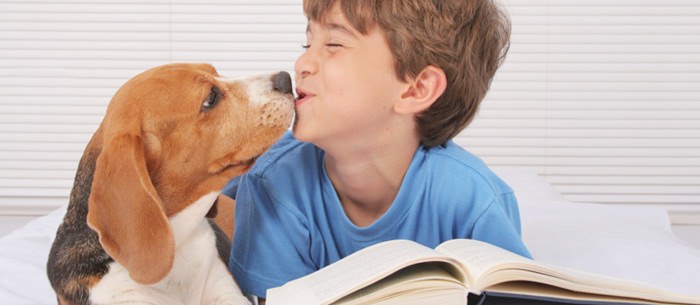Kids’ lives seem simple: eat, play, sleep and go to school. But we parents know that our kids are learning tactics to be smart, confident and hard-working adults. And the pressure can be overwhelming. The last thing we want to hear is “I hate school” or “I don’t understand my homework.” Here are some ways you can simplify some of the key school skills — in a cuddly, furry fashion — even if you don’t have a pup of your own.
-
Boost Reading Confidence
For those of us who have stage fright, we know that anxiety of presenting in front of our co-workers all too well. Believe it or not, your child may face the same anxiety when it comes to reading aloud in class. Thankfully, the Reading Education Assistance Dogs program (R.E.A.D) can help. Schools can invite therapy dogs into classroom where children can read to an unbiased, four-legged attentive listener. If your child is a dog lover and struggling with reading, suggest this program to his teacher. -
Improve Math Skills
If your child is struggling in math, incorporate daily pet calculations into your conversations. Count out treats for a day — and figure out the weekly allotment. Go over the receipts from the pet store and have her tally monthly and annual expenses; figure out the cost of a dog walker or dog sitter. Giving your child the first-hand caregiver experience can make math problems come more naturally? Ask the tutor to help use everyday situations when teaching too. Here are some examples of math problems involving dog years, dog food servings and finding distance on walks:- If a dog needs to walk 3 miles a day for enough exercise, and one lap around the field is a quarter mile, how many laps should we do?
- “Dog years” are said to be equivalent to 7 human years. If a dog is 9 years old, what is their age in human years?
- If your pet gets 1 and 1/4 cups of food each meal and is fed three times a day, how many cups do they eat in a week? How many quarts? How many gallons of food do they eat in a year?
-
Expand Geography Knowledge
Want a fun way to help your child learn the world? Get out a large map and use pushpins to match pictures of the dog breed to its origin.Here are some great dogs to start with:
- Belgium: Bloodhound
- Canada: Newfoundland
- China: Shih Tzu, Shar Pei
- Croatia: Dalmatian
- Egypt: Greyhound
- France: French Bulldog
- Germany: German Shepherd, Boxer, Pomeranian, Rottweiler
- Great Britain: Beagle, Collie, Springer Spaniel, Labrador Retriever, Golden Retriever, Sheepdog
- Ireland: Irish Setter
- Mexico: Chihuahua
- Siberia: Siberian Husky
- Switzerland: Swiss Mountain Dog, Saint Bernard
- USA: American Cocker Spaniel, Boston Terrier, Pit-bull
-
Experiment with Scientific Facts
Beyond the world of beakers and Bunsen burners, dogs can help your child learn to love science. Their behaviors, their coats, their coloring — all genetic traits that we’re sure Gregor Mendel would appreciate. Grab a dog breed guide for your child and discuss the key traits. For example, Saint Bernards have thick fur coats because they are from cold regions. Sheepdogs and Border Collies have herding instincts because they were bred to herd sheep and cattle. See what other unique traits you notice together. There might be a good lesson in cross-breeding as well. Labradoodle, anyone?Science can also explain other traits about dogs. If you have ever noticed Fido hiding under a table during a thunderstorm, it’s because a dog’s sense of hearing is ten times more acute than a humans. Dogs don’t like the sound of rain because the sound is amplified and hurts their ears. The nose of a dog can smell things 100,000 times stronger than any human. This explains why dogs are the first choice for search and rescue missions around the world. When learning about the skeletal system, be sure to tell your child that despite their breed or size, all dog breeds have 42 teeth and 321 bones. Use these traits to pique a child’s interest – and encourage an oral report on the history and science of his favorite type of dog — a nice interdisciplinary teaching technique.

